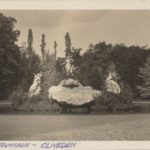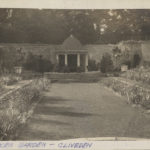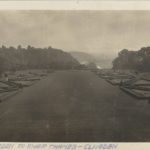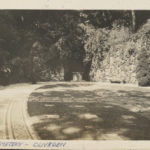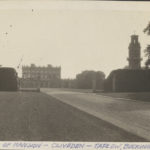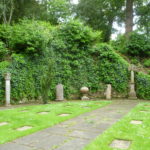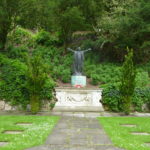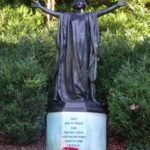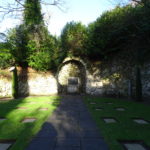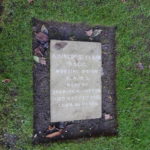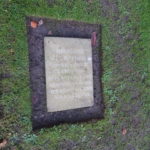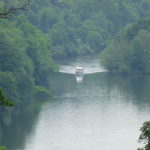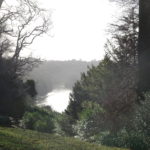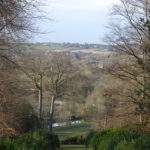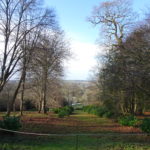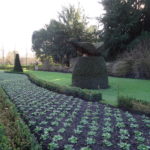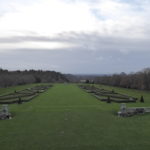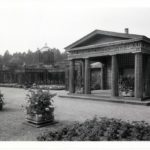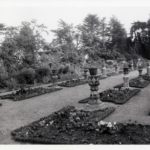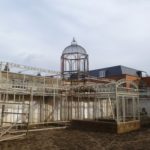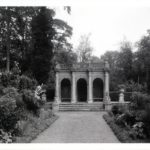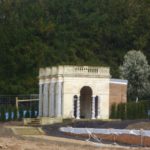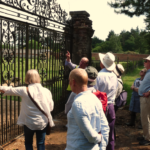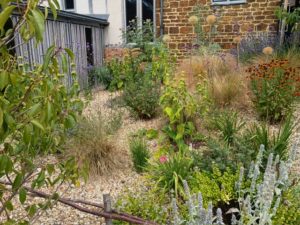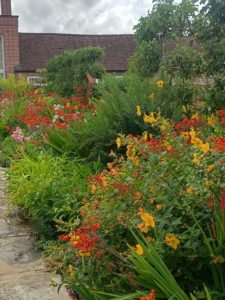 Introduction: The Bicycle Boys
Introduction: The Bicycle Boys
Image: Sam Brewster with bikes taken by Loyal Johnson, 18 August 1928.
Credit: RHS Lindley Collections
Buckinghamshire County Gardens Trust was delighted to take part in ‘The Bicycle Boys’, an exciting collaboration between the Gardens Trust and the Royal Horticultural Society.
In 1928, two young Americans embarked on an epic journey to explore Britain’s best gardens by bike. In just 3 months, Loyal Johnson and his friend Sam Brewster cycled more than 1500 miles and visited over 80 gardens across the UK. They left behind a wonderfully detailed travel journal, which Loyal’s son donated to the RHS Lindley Library in 2015. Loyal’s diary provides a fascinating snapshot of British culture and British gardens in the 1920s.
We are one of 14 County Gardens Trusts across the UK to have been following in the footsteps (or cycle tracks) of Loyal and Sam. We have researched Cliveden and Dropmore two of the many gardens that Loyal and Sam visited over the summer of 1928. Our findings featured alongside those of other County Gardens Trusts in an online exhibition: ‘The Bicycle Boys: An Unforgettable Garden Tour’, which featured on the RHS Libraries website from 8 June 2022.
The project forms part of the Gardens Trust’s Unforgettable Gardens campaign to raise awareness of the value of local parks and gardens and the importance of protecting them for our future.
Loyal’s Journey details map & chart – click here: Loyal’s journey details map
Background to the Loyal Johnson Archive
Loyal Robert Johnson (1904-1999) was born in Monte Vista, Colorado, United States of America, on
19 Oct 1904. His father was Thomas Henry Johnson, a potato and wheat farmer, and his mother
Elme Ann Watson, a travelling seamstress. As a young man he attended Colorado Agricultural and
Mechanical College in Fort Collins, Colorado (now Colorado State University). After graduation, he
pursued a Master’s degree in landscape architecture at what would become the University of
Massachusetts. For his Masters dissertation he wanted to see for himself the great gardens of the
United Kingdom.
In the summer of 1928, at the age of 25, Loyal Johnson arranged a tour of Great Britain with his
friend Sam Brewster. Together they undertook a three–month tour of English, Welsh and Scottish
gardens, covering 1500 miles on bicycles purchased at Liverpool, with their belongings in a 12–inch
case strapped to the back of each bicycle. In total the young men visited around 70 gardens,
including Munstead Wood where Gertrude Jekyll was in residence, Gravetye Manor with garden
paths adapted for William Robinson’s wheelchair, Great Dixter where they were reprimanded by
Nathaniel Lloyd who then gave them a guided tour, Aldenham House, Chatsworth, Levens Hall,
Blickling, Hestercombe House, Hoar Cross House, Compton Wynyates, Blenheim Palace, the Sutton
Nursery Company at Reading and many others.
Loyal kept a detailed diary of the trip in three volumes, describing the gardens they visited, places
they stayed and people they met, creating a historical and social record of inter–war Britain and its
gardens. They endured rain and headwinds, biting insects, poor and non–existent roads, multiple
falls from the saddle, straw beds, hunger, sickness and falling out with each other. They took
pleasure in the scenery (‘the finest I’ve ever seen – man could never even dream of heaven being so
beautiful’), the kindness of the people they met and stayed with, and larking about together.
Significantly for this project, Loyal’s notebooks capture gardens at a significant point in the history of
large country estate gardens. Ten years after the First World War, many gardens were in a state of
gradual decline as post–war death duties and income tax rises impacted on the budgets and staffing
levels of many private gardens. However the vestiges of their Victorian and Edwardian heyday were
still evident as the Great Depression and Second World War were still to come. It is also interesting
that Loyal and Sam were often shown around by the Head Gardener rather than the garden owner
so the notebooks give important information about the staffing of the gardens they visited.
Unfortunately Loyal Johnson did not complete his masters and the notebooks were never written up
into a dissertation and remained unpublished. On returning to America, he began his employment
with the Long Island Parks Department, New York, participating in the landscaping at the new Jones
Beach Park. He moved into landscape design and was involved with layouts for the new Long Island
Parkways. In the early 1930s he worked in the New York City Parks Department, and did some
landscape design work for golf course designer Robert Trent Jones. He married Madeline Margaret
Ramsauer on 18 Aug 1934, and they had four children. In 1941 his book ‘How to Landscape Your
Grounds’ was published by A.T. DeLaMare, revised in 1950. In 1951 the family moved to Baltimore,
Maryland, where Loyal Johnson worked for Martin Funnell and Associates, a landscape architecture
and city planning firm. In the early 1950s he won a landscape proposal for a community park in Bel
Air, although his inclusion of a swimming pool was rejected because of the segregation of schools
and other facilities at that time. The family moved to a small farm in Bel Air, Maryland, and a few
years later Johnson was appointed County Planner for Harford County, Maryland.
The collection of journals, photograph album and papers was donated to the RHS Lindley Library
2015-2019 by Loyal Johnson’s son, Marshall Johnson
Cliveden (House and garden Grade I)
Acquired by the National Trust 1942, House currently leased as a hotel, gardens are open to the public.
Current head gardener Anthony Mason.
Transcription of Loyal Johnson diary entry September 3 1928 CLIVEDEN:
We rode on to Maidenhead and after looking over several places we took what looked to be the lesser of a number of evils and even then got hooked a fancy price for a very insufficient dinner.
Cliveden Estate at Taplow slightly off our road was our next stop. It is owned by Viscountess Astor, Mr Cram is the head gardener and we were shown round by Mr A Jefferies a jolly old chap who has been on the place for 53 years.
Among the features of the place is the ‘long garden’ which is 180 yards long with 2 ½’ box hedges at the edge of the main axial walk which is of turf. The box hedges continue around towards the outside of the garden so as to enclose the perennial beds, being waving in their course at the back so as to vary the width of the beds, break the monotony and provide bays for pieces of topiary work. Uncle Jeff has done most of the topiary work himself and is as proud of it as a little boy with his first pair of pants.
The house is situated high above the Thames River and has many views of the river and the countryside beyond but a little judicious use of a saw and pruning shears would make considerable improvement in this respect. Winding walk, seats, azaleas, rhodos and fine big trees make the hillside a pleasant place.
During the war they had a hospital here and now have an extraordinarily fine little memorial cemetery, where the men who died here are laid to rest. Among them were a few boys from the States who were with Canadian Forces. They also have a fine memorial to the men of the estate who gave their lives in the Great war.
The Yew Tree walk leads towards the river down the southern slope under the arching branches of which one gets a nice view of the Thames. Immediately south of the garden is the Italian garden viewed from a very high terrace on the south front. North of the house is an immensely large court mostly turfed giving a view through large gates down the long axis, upon which the driveway approaches to a large Italian Fountain of a huge scallop shell and nude figures etc. west of this court is a fine little sunken garden called the ‘little garden’ and a tennis court both within the same wall.
Nancy Astor (nee Langhorne) 1879-1952 became Mistress of Cliveden in 1906 following her marriage to Waldorf Astor. She was given Cliveden as a wedding present, and she re-designed the garden and the interior. Cliveden became a party house in the 20s and 30s, and those attending became known as ‘The Cliveden Set’. In 1919 Nancy became the first female MP to take her seat in the House of Commons, and she became one of the most colourful women in British political history.
In the General Election of 30 May 1929, the Labour victory which resulted in a hung parliament, saw her majority in Plymouth slip to just 200. It was a time of economic crisis and high unemployment around the world. Later that year, the financial disaster known as the Wall Street Crash occurred on the 29 October, perhaps this was one of the reasons that Loyal did not complete his studies.
Cliveden is a majestic vision set high above the river Thames, it is a proud celebration of status and splendour. This may well have drawn Loyal to visit, along with its fascinating 250-year history (1928) and the fact that the owner was a fellow American who had married into the English aristocracy.
WWI had only ended 10 years before his visit and Cliveden is unusual in that a number of American service personal were buried (most were later repatriated) in the small cemetery, it is unusual to find a war cemetery in a private estate. A couple of nursing sisters are also commemorated they died in November 1918 possibly in the Spanish Flu pandemic.
Very little has changed at Cliveden during the last 100 years other than the garden is visited by far larger numbers of people. The National Trust have therefore had to install all the relevant facilities for public use, cafes, car parking, shops etcetera
The woods particularly to the south of the site were badly damaged in the great storms of 1987 and 1990 when more than 2,000 mature trees were lost, since then extensive re-planting has taken place, including the reinstatement of the underplanting using low laurel bushes which would have been part of the C18 designed landscape.
Most of the garden features, mentioned by Loyal in his diary remain and are certainly identifiable from his description and photographs. The Long Garden with its spectacular topiary inspired by the Italian Baroque and Renaissance gardens the 1st Lord Astor had seen in Rome, was created by Nora Lindsey (friend of Nancy Astor) in the early 1920s, Loyal would have seen it shortly after it was created. The Fountain of Love, commissioned by William Waldorf Astor in 1897, the sculptor was Thomas Waldo Story (a fellow American working in Rome). The little or sunken garden no longer survives.
The riverside walks and views of the Thames are un-altered, the views still tend to be obscured and could be opened by some pruning, as was suggested by Loyal. The memorial cemetery, with its fragments of ancient sculpture and MacKennal’s sculpture depicting ‘Canada’, remains much the same although the ornate mosaic tiles on its perimeter path have been replaced by flagstones. The C18 Yew Tree walk which leads from the parterre down to Spring Cottage on the riverside, is unchanged. The early C18 Italian Garden (now known as the Parterre), is today a simplified version of a parterre that dates from 1853 during the Duke of Sutherlands tenure. The Grand Avenue, with its tall Limes survives, however the trees are the successors to those plated by the Earl of Orkney in the C18, the inner row of limes has also been re-planted.
Loyal does not mention the grass Amphitheatre created by Charles Bridgeman in the 1720s it was the setting for the first performance of Thomas Arne’s Rule Britannia in front of Frederick, Prince of Wales in 1740. He also omits the Water Garden which had been enlarged and landscaped in 1905 by 1st Lord Astor and included a painted pagoda made for the Paris Exposition Universelle in 1867. He is probably more interested in the landscape as he does not mention the garden buildings which include, The Octagon temple, the Blenheim Pavilion or the clocktower which dominates the pleasure grounds.
In 1928 Loyal would have enjoyed un-spoilt views from the terrace across the parterre to the countryside beyond the river Thames, however today the much enlarged town of Maidenhead can be seen in the distance.
Claire de Carle 5/02/23
Courtesy of RHS Linley Library , taken by Loysl 1928.
Courtesy of Claire de Carle with permission from the National Trust
Dropmore (Registered Grade II) Eleven listed garden structures
Monday 3 September 1928 ( the garden was only open on Mondays and Saturdays)
Owner in 1928 John Beville Fortescue (1850-1938)
2022 In private ownership
Head Gardener in 1928 Mr F Reed
Loyal Johnson Journal Entry Transcription:
It was not far over to Dropmore a place owned by Mr G (error should be J) B Fortescue and where Mr F Reed is the gardener. It isn’t a lot to write home about, but they surely have a fine collection of conifers and have them well labelled and have some fine views of Windsor Castle though the distance is over 4 miles. The house was built about 1770 and the collection of confers was begun about then. Some raised from seed are giants now. I saw the largest Californian Redwoods here that I have ever seen perhaps 4 ½ to 5’ in diameter. A vast collection of Chinese pottery and chinaware line many of the garden walks and clutter up the garden generally.
John Bevill Fortescue, was the fourth and youngest son of the Hon George M and Lady Louisa E Fortescue he was born at Boconnoc in 1850, and educated at Eton and Balliol College, Oxford where he read Law. He was called to the Bar in 1875. He married Dorothy Hoste in 1891 and inherited the estates at Boconnoc and Dropmore. His mother, Lady Louisa E Fortescue, who had lived at Boconnoc since 1833, moved to Dropmore for the remaining years of her life. Bevill, as he was known in the family, was High Sheriff of Cornwall in 1894 and a JP (Hampshire Archive/
https://discovery.nationalarchives.gov.uk/details/r/eca58549-972b-4768-b35a-701bb6e8cd2c
Johnson may have been aware of the renowned pinetum at Dropmore and as many of the tree were native to North America these would have been of interest. Dropmore is only a short distance from the more grandiose gardens at Cliveden and would have been on route to his next stop Windsor.
Lord William Grenville acquired the estate in 1792 with the aim of making it a horticultural heaven (Gedyes). Philip Frost was the head gardener at Dropmore for 54 years from 1832 the Fortescues relied heavily on Frost’s knowledge and pioneering vision. In recognition of his work at Dropmore Volume 22 of The Garden was dedicated to him, he also featured in The Gardener’s Chronicle in 1875. Dropmore’s pinetum is undoubtedly its foremost feature, however it also has a wonderful aviary.
Loyal was fortunate to visit Dropmore in 1928 as 10 years later, following the death of John Fortescue it had begun its steady decline. During WWII the estate was requisitioned by the army and suffered from neglect. Throughout the second half of the C20 Dropmore was inaccessible, an abandoned estate going to wrack and ruin. It has undergone restoration during the C21, the current owner had to reverse the damage done by a serious fire in 1990 and a failed development to turn the house into flats.
Some of the garden features remain, but in 2016 all needed restoration and re-planting, more of this work may well have been carried out since the Gardens Trust visit in 2016.
The wider, informal landscape contains an internationally important Pinetum and significant collection of rhododendrons and azaleas. As a result of lack of management during the second half of the 20th century many of the garden structures were in parlous state and large parts of the woodland had become completely overgrown (Colston Stone).
The only photo taken by Loyal of Dropmore is of the garden front of the house, today the treillage on the house has gone and it has a more open aspect (2016). Despite Loyal’s comments about it not being much to write home about, historic images show the extensive pleasure grounds were well tended during the 1920s.
In 2016 I organised a visit on behalf of the Gardens Trust to Dropmore, prior to this I also went on a recce to the site. We contacted the landscape architects Colston Stone, and we were given access, accompanied by the contractors. I therefore had a good opportunity to see the restoration work in the garden and to take photographs, I knew this might be my only opportunity. David Gedye also accompanied the groups on the visit as he was able to draw on his research of the pinetum in particular the monkey puzzle trees and Philip Frost (his ancestor).
Conservation Management Plans are in place and Colston Stone have prepared detailed proposals for the restoration of the garden. They have also prepared detailed management plans for the wider estate and procured a team of gardeners, to restore the Pinetum, woodland and parkland landscapes. Currently (2022) no access available.
https://www.colsonstone.co.uk/conservation-dropmore-buckinghamshire.html
References
Buckinghamshire Gardens Trust Newsletter Issue 15 Late Summer 2002 and Autumn 2009
Country Life 120 11/10/56 pp772-5, 18/10/56 pp834-7, 140 4/8/66 p263.
Gardeners Chronicle 25/10/1872, 14/5/1887 – Philip Frost obituary
Araucaria – The Monkey Puzzle Tree David Gedye (2019)
Claire de Carle 05/02/23
1890 (ref unknown) the vast collection of chinaware referred to by Loyal

